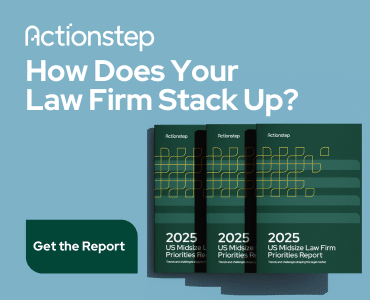The constant influx of emails can be overwhelming, making it hard to keep up with urgent client communications and focus on client work. Achieving an empty inbox, or ‘inbox zero’, is a key goal for effective email management. With a few easy Outlook tricks, you can transform your inbox from a source of stress into an organized workflow hub.

Table of contents
- Email Overload
- Setting up Outlook for Efficiency
- Try These Easy Outlook Tips
- 1. Automate Incoming Messages Organization With Outlook Rules
- 2. Streamline Repetitive Tasks With Quick Steps
- 3. Use Categories for Quick Sorting and Prioritization
- 4. Move Emails to Microsoft To Do for Action
- 5. Clear Your Inbox Quickly to Manage Email Overload
- Get More Out of the Software You Use Every Day
Email Overload
What is Email Overload and How it Affects Productivity
Email overload, also known as email fatigue, is a problem that affects professionals in all industries including law. It’s the feeling of being overwhelmed by the sheer volume of incoming emails and not being able to manage and respond to them quickly. This constant stream of emails can really impact productivity, leading to decreased efficiency, increased stress and burnout. When your inbox is full it’s hard to prioritize, focus on important emails and respond in a timely manner. Understanding and tackling email overload is key to a manageable inbox and making sure important communications don’t get lost in the noise.
Causes of Email Overload at Work
Several factors contribute to email overload in the workplace so it’s a big problem. Here are some of the common causes:
- High Volume of Incoming Emails: From important emails to marketing emails and long conversation threads, the sheer volume of emails is overwhelming.
- Ineffective Email Management: Without filtering, categorizing and prioritizing emails can quickly get out of control and clutter your inbox.
- Not Enough Time for Email Management: Not allocating enough time to manage emails can lead to a backlog of unread emails and make it harder to keep on top of communications.
- Poor Email Habits: Sending unnecessary emails or using email as a substitute for instant messaging or phone calls can contribute to email overload.
- No Training on Email Management: Without training on best practices many professionals struggle to use email tools and features effectively.
Now that you know the common causes of email overload you can take action to manage it and have a more organized and efficient inbox.
Setting up Outlook for Efficiency
Basic Principles of Good Time Management
To manage email overload you need to set up Outlook for maximum efficiency and follow basic principles of good time management. Here are some practical tips to get you started:
- Centralise Your Inbox: Reduce the number of places you read messages by setting up a centralised inbox and avoiding multiple email accounts. This will streamline your email management.
- Automate Sorting: Let some messages pass by setting up filters and rules to automatically sort and prioritise emails. This will reduce manual sorting and keep your inbox focused on actionable items.
- Simplify Filing: Reduce the number of places you manually file messages by using a single reference folder instead of multiple folders. This will make it easier to find and manage emails.
- Process Efficiently: Use the Four Ds — Delete, Do, Delegate, Defer — to process your messages. This will help you quickly decide what action to take with each email.
- Integrate Your To-Do List: Reduce your to-do list to one list by integrating your task list with your email inbox. This will ensure all your tasks are in one place and make it easier to manage your workload.
- Batch Your Work: Allocate specific times to manage email overload and respond to emails. Working in batches will improve your focus and efficiency.
- Send Thoughtfully: Use good judgment when sending messages by considering the recipient, the subject line and the content of the email. Clear and concise communication will reduce unnecessary back and forth emails.
By following these principles, you can set up Outlook for efficiency and effectively manage email overload, leading to a more organized and productive workday.
Try These Easy Outlook Tips
Managing email effectively is crucial to staying organized and responsive. The pressure to provide an immediate response can lead to constant email checking, which negatively impacts productivity and work-life balance. By using Outlook’s advanced features — rules, Quick Steps, categories, and integrations with Microsoft To Do — you can build a streamlined system that lets you handle emails efficiently and keep your inbox clean.
1. Automate Incoming Messages Organization With Outlook Rules
Outlook rules allow you to automate how incoming emails are handled, reducing the manual sorting and prioritizing that can eat up your day. By setting up rules, you can ensure that specific types of emails are automatically moved to designated folders, flagged or categorized.
Here are a few rule ideas tailored for small firm lawyers:
- Categorize by Practice Area: Use subject keywords or sender information to apply categories based on practice areas like litigation, estate planning or corporate law. This way, emails are color-coded and ready for quick filtering.
- Mark Routine Emails: Set rules to automatically mark newsletters or internal updates as read and move them to a low-priority folder. This reduces distractions and keeps your inbox focused on actionable messages.
By automating control over what lands in your inbox, you’ll free up time and reduce the risk of missing critical emails buried in clutter.
2. Streamline Repetitive Tasks With Quick Steps
Quick Steps in Outlook can simplify repetitive actions into one-click processes, helping you handle emails faster and move on to more important tasks. Using an instant message for quick responses can further streamline communication, allowing you to obtain prompt replies without switching between different apps. You can create custom Quick Steps that fit your unique workflow, whether it’s delegating tasks, moving emails to specific folders, or converting emails into tasks.
Some useful Quick Steps for lawyers include:
- Reply, Flag and Move: A single click can send a pre-drafted response, flag the email for follow-up, and move it to a designated folder.
- Create a Task in To Do: Automatically add an email as a task in Microsoft To Do and move it out of your inbox. This is particularly helpful when emails represent actions you need to take later.
- Delegate and Archive: Forward an email to a colleague or assistant, then instantly archive it, clearing your inbox while ensuring the task is in the right hands.
These Quick Steps eliminate the need for multiple clicks and decisions, speeding up your email triage process.he need for multiple clicks and decisions, speeding up your email triage process.
3. Use Categories for Quick Sorting and Prioritization
Categories in Outlook allow you to color-code emails, making it easier to visually prioritize tasks and track related communications. Email overload is more than just a nuisance; it can significantly impact productivity and mental health. Categorizing by urgency, practice area or client can make scanning your inbox and planning your day much more efficient.
Some effective category strategies include:
- Client-Specific Categories: Assign a unique color to each of your key clients, so their emails stand out immediately in your inbox.
- Task Status Categories: Use categories like “To Do,” “Waiting for Response” and “Completed” to quickly gauge the status of ongoing tasks.
- Urgency Tags: Categories like “High Priority,” “Follow Up Today” and “Review Later” help you quickly sort and address your most pressing issues.
Pairing categories with search filters and rules can create a highly tailored email management system.Pairing categories with search filters and rules can create a highly tailored email management system.
4. Move Emails to Microsoft To Do for Action
Not every email can be dealt with immediately. To overcome email overload, it is crucial to take action and manage your emails effectively. For those that require follow-up or further action, converting them into tasks in Microsoft To Do is a great way to stay organized. With Outlook’s To Do integration, you can ensure that important tasks don’t get lost in your inbox.
Here’s how to make this process seamless:
- Drag and Drop: Simply drag an email to create a new task. Assign a due date, add it to a list, and categorize it for easy tracking.
- Flag Emails to Sync With To Do: When you flag an email in Outlook, it automatically appears as a task in Microsoft To Do. You can then manage it alongside your other tasks, giving you a unified view of what needs to be done.
- Use To Do Reminders: Set reminders within To Do so you don’t lose track of tasks associated with important emails, even if you’ve moved them out of your inbox.
This approach helps you stay on top of commitments without leaving tasks buried in your inbox.buried in your inbox.
5. Clear Your Inbox Quickly to Manage Email Overload
The key to keeping an organized inbox is quickly moving unwanted emails out once you’ve acted. Whether it’s replying, forwarding or setting up a follow-up task, your goal should be to handle each email and then get it out of your inbox.
Here’s how to efficiently clear your inbox:
- Use Archive Aggressively: Don’t let emails sit around after you’ve addressed them. Archive them immediately to keep your inbox clean while still retaining easy access if needed.
- One-Click Move to Folder: Use Quick Steps or drag-and-drop to instantly move emails to relevant folders based on client, case or project once you’re done.
- Set Up “Waiting for Response” Folders: If you’re waiting for someone else to take action, move the email to a “Waiting” folder, categorized for easy follow-up without cluttering your main inbox.
Keeping your inbox clear not only reduces stress but also makes it easier to stay focused on your highest priorities.nbox clear not only reduces stress but also makes it easier to stay focused on your highest priorities.
Get More Out of the Software You Use Every Day
Check out Affinity Consulting Group’s legal-specific software manuals.
About Affinity Consulting Group
Affinity Consulting Group inspires, enables, and empowers legal teams of all sizes to work smarter, from anywhere. The company’s holistic approach incorporates people, process, and technology. Affinity’s passionate, well-connected industry experts work hand in hand with you to help you better understand and optimize your business — from software to growth strategy, and everything in between.
©iStockphoto.com

Sign up for Attorney at Work’s daily practice tips newsletter here and subscribe to our podcast, Attorney at Work Today.
















